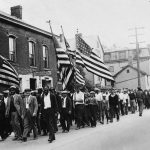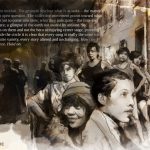Book Review | The Water Dancer by Ta-Nehisi Coates
Ta-Nehisi Coates’ first work of fiction, which reflects on the power of memory, follows an enslaved man with superhuman capabilities who joins the underground resistance.
Author:
10 December 2019

One of the many tasks of the writer is to remember in words, so that we may all remember too. Recollection is a potent mechanism for creating new mythologies of black life and futures. Ta-Nehisi Coates’ vocation has been the work of memory, for to acknowledge the past, against what is understood as “American history”, is to honour the present with an insistent truth. Only then can a proper collective healing and equity begin.
Prior to penning his first novel, The Water Dancer, Coates wrote non-fiction, focusing on race, culture and politics. His second book, Between The World and Me, tackles the precarious nature of black people navigating America as sites of mistreatment and segregation. Written as a letter to his adolescent son, the multi-award winning book incorporates history, personal narratives and current discourses to provide an understanding of African-American existence in the present. But it was his seminal essay a few years before, The Case for Reparations, which brought him acclaim as an intellectual icon and formidable writer.
The masterful essay extensively documents the legacy of slavery and later segregation laws thrust upon black American lives. Using powerful historical examples and various experiences, he provides a strong case for reparations. Reparations demand descendants of Africans who were enslaved be compensated for the injustice of slavery, as the effects of it persist in African- American reality. Coates draws attention to the possible reason the topic of reparations is a challenging discussion for Americans.
Related article:
“The idea of reparations threatens something much deeper – America’s heritage, history and standing in the world,” Coates writes.
This threat to American history is directly linked to how we remember in order to create certain existing realities of life. The erasure of oppressed histories absolves contemporary white societies of responsibility in honestly pursuing the project of social cohesion and parity.
He continues: “Reparations – by which I mean the full acceptance of our collective biography and its consequences – is the price we must pay to see ourselves squarely.”
An entry into fiction
The Water Dancer may be Coates’ first fictional work but the novel continues the tradition of his non-fiction work. Memory and remembering run as fundamental themes throughout the book, ideas which pervade most of his previous writing too.
The novel’s protagonist, Hiram Walker, is a slave born to a white master and black slave mother on a plantation, known as Lockless. His photographic memory is a talent that earns him favour with his white father. Even with this gift, there is one exception – Hiram cannot remember his mother, whom his father sold off. He later discovers he possesses the superhuman ability of “conduction” – to fold space and time and transport people via water bodies.
Coates meditates on the concept of memory and remembering by giving the protagonist a photographic memory and conduction that seems to require accessing the memories of his mother. Many of the characters seem to have an innate hope and understanding that recollection – of their sore realities, folklores, histories – is where the answers to their freedom lies.
Of course, the relationship of remembering and forgetting, is an allegory of the American psyche and how white America uses this ability “to forget histories” to enable their complicity in creating a legacy that disregards the effects of slavery on modern black life. To remember is to surrender to accountability. Not knowing is the white super power wielded to sustain white hegemony while accessing collective memory is the black super power employed for liberation. “To forget is to truly die,” a character in the book says. Black people continue to be bludgeoned by poverty, segregation, police brutality. Restoration begins with never forgetting.
Slavery remains a gash in America’s history and a reality that refuses to heal due to the suppuration of white denial, which maintains a structure encrypted with a terrorism targeted at black people. Coates is constant in his intention to remind us to recall that our realities are the consequence of historical atrocities that happened to black people.
An imposed reality
“People were not slaves, they were enslaved,” the writer says in an interview at Google Zeitgeist. He calls for us to remember that calling people slaves alludes to it being a vocation, an identity even. Yet using “enslaved” eschews this idea by locating it as a reality that was imposed on black people. Reminiscent of Toni Morrison, who is the author’s biggest influence, in the novel the enslaved are called “The Tasked” and the white agents of slavery are called “The Quality”. The choice in naming it in this manner has the markings of speculative fiction leanings but it also creates an alternate imagining of that specific history. To change the meaning of words or use them differently allows for this creation.
By using this literary trope, Coates merges an assortment of genres to create The Water Dancer. The novel cuts across genres in expansive imagination, meticulous historical detail and incorporation of the supernatural. Even in his descriptions, Coates conjures up with great detail the interior lives of the enslaved, which we can attribute to his experience as a journalist. When you consider that it did take him the last decade to write the book, you appreciate the insistent focus on historical accuracy.
The black family remains a unit tarnished with an inaccurate pathology, treated as if affected by an unavoidable condition. Slavery is the source that fractured the black nuclear family, because many family members were sold off at any given time and some never reunited. Dismembering black families weakened and broke the black spirit. Hiram treasures his plantation family: from his adoptive mother Thena, a secretive woman who knew his mother, to Sophia, who is kept at the plantation as his uncle’s concubine.
Related article:
His white father later assigns him to be his half-brother’s personal slave to watch over him. His tactless brother, Maynard, is the archetype of a spoilt, rich white boy who almost squanders the family’s wealth gambling. The many manifestations of family exist throughout the book, even when Hiram joins the underground. Coates requests us to consider how the concept of the black family is not monolithic because slavery forced biologically unrelated people to create familial bonds for companionship and survival. Their shared biology is a harrowing injustice, floggings and disenfranchisement. But even within this violence, the black family emerges as a unit of love.
But once Hiram leaves Lockless, the rhythm of the book changes. He joins the underground war on enslavement and connects with underground leader “Moses”, who also has the ability to “conduct”. The suspense deepens as he must learn how to harness his powers, confront the truth of his mother and the burning need to return to his first home to save those he loves. The book becomes about assembling resistance, gathering under the defiance to free the other enslaved. Hiram himself feels more emboldened compared to the one we have encountered in previous chapters. As he is within the ranks, realising the vital use of his powers gives him a newfound tenacity.
The symbolism of water
Hiram’s ability to transport himself and people via water bodies is the genius of this novel. Coates purposefully uses the water metaphor to be an antithesis to the slave trade. Thousands of Africans were transported on ships over the ocean.
Water symbolises a dark history and spiritual conduit for black people. As Koleka Putuma says in her poem Water, “It’s as if the reeds remember that they were once chains/And the water, restless, wishes it could spew all of the slaves and the ships onto shore/whole as they had boarded, sailed and sunk/their tears are what have turned the ocean salty.”
Her words, alongside Coates, highlight why water bodies appear in many incarnations of black mysticism and fantasy. Through Hiram liberating slaves via water bodies, Coates puts up a new mythology for us to consider.
The Water Dancer provides the opportunity for us to consider alternate versions our history as black people that allows us to be bold and inspirational.
The novel may suffer from confusing prolonged story arcs but Coates has penned a strong fictional debut that does not stray too far from his non-fictional work as he continues to create a canon of work that is consistent in its identity – to never forget, for historical amnesia is the true death.


